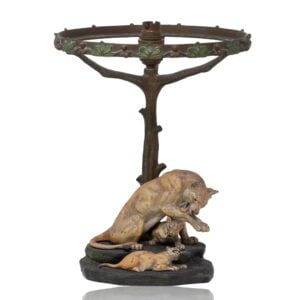Description
Early 20th century Vienna bronze of Psyche by Franz Mazura, likely Bruno Zach.
From our Bronze Sculpture collection, we are delighted to present this Austrian Bronze Sculpture of Psyche, also known as the “Butterfly Woman,” signed by Franz Mazura.
Dating to the early 20th century, this finely cast and patinated bronze depicts Psyche, the mythological figure symbolising the soul, portrayed with delicate butterfly wings. The elegant figure is sensitively modelled, shown in a graceful pose with flowing drapery, and raised upon an ebonised wooden base.
The subject of Psyche, often represented with butterfly wings, became a celebrated motif in the decorative arts of the late 19th and early 20th centuries. Comparable in spirit to the iconic Rolls Royce “Spirit of Ecstasy,” this sculpture reflects the period’s fascination with allegorical themes and sensual form.
The piece is signed to the rear F. Mazura for Franz Mazura, an Austrian sculptor active in Vienna during the early 20th century. While little biographical information is known, it is widely believed that Franz Mazura was a pseudonym used by the renowned Austrian sculptor Bruno Zach, famed for his sensual and striking bronzes of the Art Deco and Jugendstil movements.
This rare example offers collectors both aesthetic beauty and historical intrigue, making it a superb addition to any collection of Austrian or Viennese bronzes.
Psyche
In classical mythology, Psyche is the immortal wife of Eros (Cupid), the Greek god of love and desire. She is most often depicted as a beautiful woman with delicate butterfly wings, symbolising the soul. Her story, recorded in Apuleius’ The Golden Ass (2nd century), tells of her trials set by Venus, her reconciliation with Cupid, and her eventual immortality. Psyche’s enduring image has inspired centuries of art, sculpture, and literature, making her a recurring emblem of love, beauty, and transformation.
For further information on Psyche please see our article Psyche in Mythology and Art: The Butterfly-Winged Soul.
BRONZE
Bronze has been one of the most widely used materials in art and design for centuries, valued for its strength, durability, and ability to capture fine detail. Popular from ancient civilisations to the 19th century, bronze has been used for statues, decorative objects, and functional pieces alike. In the late 19th century, artists in Vienna, including Franz Xaver Bergmann, perfected the technique of cold-painting, adding rich layers of colour to bronze without firing. This innovation, along with the timeless appeal of bronze’s patina and texture, ensures that antique bronze objects remain highly collectible today.
For further information please see our article Bronze Sculpture: History, Composition, and Casting Techniques.
Bruno Zach (1891–1935)
Bruno Zach was a Ukrainian-born Austrian sculptor celebrated for his Art Deco and Art Nouveau works, particularly his provocative and erotic bronzes. After studying in Vienna, he became known for chryselephantine sculptures combining bronze and ivory, often depicting athletic, sensual women. Zach signed works under his own name as well as pseudonyms such as Prof. Tuch and K. Salat. His sculptures ranged from decorative subjects to controversial pieces like The Riding Crop and The Hugger, which captured the nightlife and risqué culture of 1920s–30s Berlin. His bronzes, sometimes cold-painted or polychromed, were edited by firms including Argentor-Werke and Franz Bergmann. Today, Zach’s works remain highly sought after by collectors worldwide.
MEASUREMENTS
26cm High x 16cm Wide x 11cm Deep (10.24 x 6.3 x 4.3 Inches)
Figure 19.5cm High
CONDITION
Excellent Antique Condition
With every purchase from Jacksons Antique, you will receive our latest product guide, certificate of authenticity, full tracking information so you can monitor your shipment from start to finish and our personal no-hassle, money-back policy giving you that extra confidence when purchasing. Don’t forget to sign up to our free monthly newsletter for 10% off your first online purchase.





















